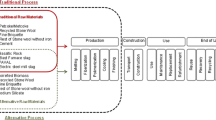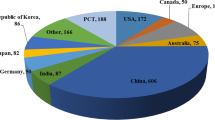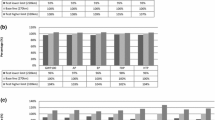Abstract
This study is a life cycle assessment (LCA) of conventional asphalt binder versus bio-modified binder that is produced by mixing asphalt binder with bio-binder obtained from swine manure. Both processes were evaluated and compared in terms of their contribution to global warming, using a global warming potential index and energy consumption. This LCA study uses a cradle-to-gate approach for the binder and includes a comparison between the environmental impacts of swine manure in lagoons and the production of bio-binder. The results show the energy consumption and global warming potential improvements after using bio-binder as a sustainable additive.






Similar content being viewed by others
References
AASHTO (1998) Resistance to plastic flow of bituminous mixtures using Marshall apparatus. American Association of State Highway and Transportation Officials, Standard specifications for transportation materials and methods of sampling and testing part II tests, 19, T 245-97
AASHTO (2004) Standard method of test for preparing and determining the density of hot mix asphalt (HMA) specimens by means of the superpave gyratory compactor. American Association of State Highway and Transportation Officials, T 312
Akiya N, Savage PE (2002) Roles of water for chemical reactions in high-temperature water. Chem Rev 102(8):2725–2750
Amon B, Kryvoruchko V, Amon T, Zechmeister-Boltenstern S (2006) Methane, nitrous oxide and ammonia emissions during storage and after application of dairy cattle slurry and influence of slurry treatment. Agric Ecosyst Environ 112(2):153–162
Anderson G, Smith R, Bundy D, Hammond E (1987) Model to predict gaseous contaminants in swine confinement buildings. J Agric Eng Res 37(3):235–253
Asphalt Pavement Environmental Council and Association, N. A. P. (2000) Best Management practices to minimize emissions during HMA construction. Asphalt Pavement Environmental Council
ASTM E 1269 (2005) Standard test method for determining specific heat capacity by differential scanning calorimetry. ASTM International, West Conshohocken
ASTM D1946–90 (2015) Standard practice for analysis of reformed gas by gas chromatography e1. ASTM International, West Conshohocken
ASTM D-5504 (2012) Standard test method for determination of sulfur compounds in natural gas and gaseous fuels by gas chromatography and chemiluminescence. ASTM International, West Conshohocken
Athena Research Institute (2006) A life cycle perspective on concrete and asphalt roadways: embodied primary energy and global warming potential. Retrieved from Ottawa, Canada: Cement Association of Canada
Brown-Brandl T, Nienaber JA, Xin H, Gates RS (2004) A literature review of swine heat production. Trans Am Soc Agric Eng 47(1):259–270
Cantrell KB, Ducey T, Ro KS, Hunt PG (2008) Livestock waste-to-bioenergy generation opportunities. Bioresour Technol 99(17):7941–7953
Chae K, Jang A, Yim S, Kim IS (2008) The effects of digestion temperature and temperature shock on the biogas yields from the mesophilic anaerobic digestion of swine manure. Bioresour Technol 99(1):1–6
Chan YH, Yusup S, Quitain AT, Tan RR, Sasaki M, Lam HL, Uemura Y (2015) Effect of process parameters on hydrothermal liquefaction of oil palm biomass for bio-oil production and its life cycle assessment. Energy Convers Manag 104:180–188
Dämmgen U, Schulz J, Klausing HK, Hutchings NJ, Haenel H-D, Rösemann C (2012) Enteric methane emissions from German pigs. Landbauforschung 62(3):83–96
de Sousa P, Pedersen S (2004) Ammonia emission from fattening pig houses in relation to animal activity and carbon dioxide production. Agric Eng Int CIGR J 6:13
Dong H, Zhu Z, Shang B, Kang G, Zhu H, Xin H (2007) Greenhouse gas emissions from swine barns of various production stages in suburban Beijing. China Atmos Environ 41(11):2391–2399
EPA (2017) Measurement of gaseous organic compound emissions by gas chromatography. In: Method 18
Fini EH, Yang SH, Xiu S (2010) Characterization and application of manure-based bio-binder in asphalt industry. Paper presented at the Transportation Research Board 89th Annual Meeting
Fini EH, Kalberer EW, Shahbazi A, Basti M, You Z, Ozer H, Aurangzeb Q (2011) Chemical characterization of biobinder from swine manure: sustainable modifier for asphalt binder. J Mater Civ Eng 23(11):1506–1513
Fini EH, Al-Qadi IL, You Z, Zada B, Mills-Beale J (2012) Partial replacement of asphalt binder with bio-binder: characterisation and modification. Int J Pavement Eng 13(6):515–522
Finkbeiner M, Inaba A, Tan R, Christiansen K, Klüppel HJ (2006) The new international standards for life cycle assessment: ISO 14040 and ISO 14044. Int J Life Cycle Assess 11(2):80–85
Franklin Associates (2011) Cradle-to-gate life cycle inventory of nine plastic resins and four polyurethane precursors. The Plastics Division of the American Chemistry Council, Prairie Village
Gibbs M, Jun P, Gaffney K (1999) N2O and CH4 emissions from livestock manure. Paper presented at the background paper for IPCC expert meeting on good practice in inventory preparation: agricultural sources of methane and nitrous oxide
Goudnaan F, Van de Beld B, Boerefijn FR, Bos GM, Naber JE, Van der Wal S, Zeevalkink JA (2008) Thermal efficiency of the HTU® process for biomass liquefaction. In: Progress in thermochemical biomass conversion, pp 1312–1325
Hakkinen T, Makela K (1996) environmental impact of concrete and asphalt pavements in environmental adaptation of concrete. Technical Research Center of Finland
Hellmann B, Zelles L, Palojarvi A, Bai Q (1997) Emission of climate-relevant trace gases and succession of microbial communities during open-windrow composting. Appl Environ Microbiol 63(3):1011–1018
Hosseinnezhad S, Johnson C, Oldham D, Fini EH (2016) Investigating the effect of processing parameters on bio-binder characteristics. Paper presented at the Transportation Research Board 95th annual meeting
Intergovernmental Panel on Climate Change (1995) IPCC guidelines for national greenhouse gas inventories, IPCC WGI Technical Support Unit
IPCC Intergovernmental Panel on Climate Change (2006) Guidelines for national greenhouse gas inventories. CD ou no site: www.ipcc.ch. Guia de Boas Práticas
ISO14040 (2006) 14040: Environmental management–life cycle assessment–principles and framework. British Standards Institution, London
Jarret G, Martinez J, Dourmad J-Y (2011) Pig feeding strategy coupled with effluent management–fresh or stored slurry, solid phase separation–on methane potential and methane conversion factors during storage. Atmos Environ 45(34):6204–6209
Jeppsson K-H (2000) SE—structure and environment: carbon dioxide emission and water evaporation from deep litter systems. J Agric Eng Res 77(4):429–440
Kebreab E, Clark K, Wagner-Riddle C, France J (2006) Methane and nitrous oxide emissions from Canadian animal agriculture: a review. Can J Anim Sci 86(2):135–157
Lashof DA, Ahuja DR (1990) Relative contributions of greenhouse gas emissions to global warming. Nature 344(6266):529–531
Mills-Beale J, You Z, Fini E, Zada B, Lee CH, Yap YK (2012) Aging influence on rheology properties of petroleum-based asphalt modified with biobinder. J Mater Civ Eng 26(2):358–366
Mogawer WS, Fini EH, Austerman AJ, Booshehrian A, Zada B (2012) Performance characteristics of high RAP bio-modified asphalt mixtures. Paper presented at the Transportation Research Board 91st annual meeting
Møller HB, Sommer SG, Ahring BK (2004) Biological degradation and greenhouse gas emissions during pre-storage of liquid animal manure. J Environ Qual 33(1):27–36
Monteny GJ, Bannink A, Chadwick D (2006) Greenhouse gas abatement strategies for animal husbandry. Agric Ecosyst Environ 112(2):163–170
Moody CJ, Harwood LM (1989) Experimental organic chemistry: principles and practice. Blackwell Scientific, Oxford
National Crushed Stone Association (1977) Flexible Pavement Cost Estimating Guide: inflation/energy effects, worksheets, SPEC data, featuring the economy of crushed stone bases. National Crushed Stone Association
Ni J, Vinckier C, Coenegrachts J, Hendriks J (1999) Effect of manure on ammonia emission from a fattening pig house with partly slatted floor. Livest Prod Sci 59(1):25–31
Nisbet M, Marceau M, VanGeem M, Gajda J (2001) Environmental life cycle inventory of Portland cement concrete and asphalt concrete pavements. Portland Cement Association. PCA R&D Serial (2489)
Ocfemia K, Zhang Y, Funk T (2006) Hydrothermal processing of swine manure into oil using a continuous reactor system: development and testing. Trans ASABE 49(2):533–541
Pedersen S, Sällvik K (2002) Heat and moisture production at animal and house levels. 4th Report of Working group on climatization of animal houses. CIGR. Horsens
Pedersen S, Blanes-Vidal V, Jørgensen H, Chwalibog A, Haeussermann A, Heetkamp MJW, Aarnink AJA (2008) Carbon dioxide production in animal houses: a literature review. Agric Eng Int CIGR J 9:19
Philippe FX, Nicks B (2015) Review on greenhouse gas emissions from pig houses: production of carbon dioxide, methane and nitrous oxide by animals and manure. Agric Ecosyst Environ 199:10–25
Philippe FX, Laitat M, Canart B, Vandenheede M, Nicks B (2007a) Comparison of ammonia and greenhouse gas emissions during the fattening of pigs, kept either on fully slatted floor or on deep litter. Livest Sci 111(1):144–152
Philippe FX, Laitat M, Canart B, Vandenheede M, Nicks B (2007b) Gaseous emissions during the fattening of pigs kept either on fully slatted floors or on straw flow. Animal 1(10):1515–1523
Philippe FX, Laitat M, Nicks B, Cabaraux J-F (2012) Ammonia and greenhouse gas emissions during the fattening of pigs kept on two types of straw floor. Agric Ecosyst Environ 150:45–53
Rebitzer G, Ekvall T, Frischknecht R, Hunkeler D, Norris G, Rydberg T, Pennington DW (2004) Life cycle assessment: part 1: framework, goal and scope definition, inventory analysis, and applications. Environ Int 30(5):701–720
Rodhe LK, Abubaker J, Ascue J, Pell M, Nordberg Å (2012) Greenhouse gas emissions from pig slurry during storage and after field application in northern European conditions. Biosyst Eng 113(4):379–394
Santero NJ, Masanet E, Horvath A (2011) Life-cycle assessment of pavements. Part I: critical review. Resour Conserv Recycl 55(9):801–809
Stammer Jr RE, Stodolsky F (1995) Assessment of the energy impacts of improving highway-infrastructure materials (No. ANL/ESD/TM–115). Argonne National Lab., IL (United States)
Stripple H (2001) Life cycle assessment of road. A pilot study for inventory analysis, 2nd revised edn. Report from the IVL Swedish Environmental Research Institute, 96
Van’t Klooster C, Heitlager B (1994) Determination of minimum ventilation rate in pig houses with natural ventilation based on carbon dioxide balance. J Agric Eng Res 57(4):279–287
Vedrenne F, Béline F, Dabert P, Bernet N (2008) The effect of incubation conditions on the laboratory measurement of the methane producing capacity of livestock wastes. Bioresour Technol 99(1):146–155
WCED (1987) Our common future World Commission on Environment and Development (WCED). Oxford University Press, Oxford
West RC, Watson DE, Turner PA, Casola JR (2010) Mixing and compaction temperatures of asphalt binders in hot-mix asphalt. (No. Project 9-39)
Xiu S, Shahbazi A (2012) Bio-oil production and upgrading research: a review. Renew Sustain Energy Rev 16(7):4406–4414
Xiu S, Shahbazi A, Shirley V, Cheng D (2010) Hydrothermal pyrolysis of swine manure to bio-oil: effects of operating parameters on products yield and characterization of bio-oil. J Anal Appl Pyrol 88(1):73–79
Yu B, Lu Q (2012) Life cycle assessment of pavement: methodology and case study. Transp Res Part D Transp Environ 17(5):380–388
Acknowledgements
The research is sponsored by the National Science Foundation (Award No: 1546921). The content of this paper reflects the view of the authors, who are responsible for the facts and the accuracy of the data presented. The authors would like to acknowledge Sustainable Infrastructure Materials Laboratory at NC A&T State University for providing information on bio-residue processing.
Author information
Authors and Affiliations
Corresponding author
Rights and permissions
About this article
Cite this article
Samieadel, A., Schimmel, K. & Fini, E.H. Comparative life cycle assessment (LCA) of bio-modified binder and conventional asphalt binder. Clean Techn Environ Policy 20, 191–200 (2018). https://doi.org/10.1007/s10098-017-1467-1
Received:
Accepted:
Published:
Issue Date:
DOI: https://doi.org/10.1007/s10098-017-1467-1




